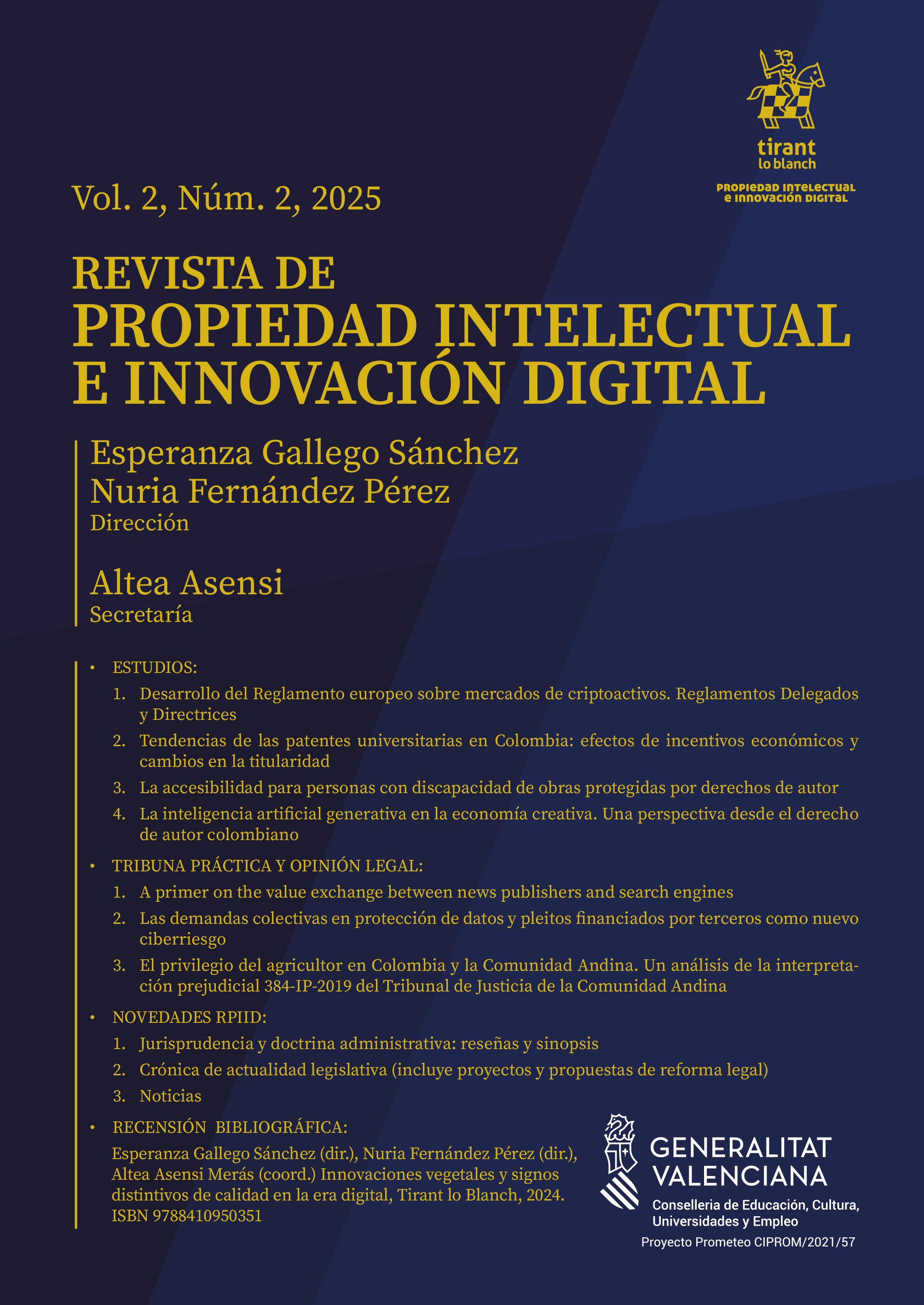The farmer’s privilege in Colombia and the Andean Community: Court of Justice of the Andean Community. An analysis of prejudicial interpretation 384-IP-2019 of the Court of Justice of the Andean Community
DOI:
https://doi.org/10.36151/RPIID.2025.2.2.07Keywords:
farmer’s privilege, UPOV, plant breeder’s right, Andean Decision 345 of 1993, exhaustion of the breeder’s right, prejudicial interpretation 384-IP-2019 of the Court of Justice of the Andean CommunityAbstract
The article analyzes the farmer’s privilege in the Colombian context and the Andean Decision 345 of 1993, contrasting it with the 1978 and 1991 Acts of the UPOV Convention. It is argued that the farmer’s privilege, understood as an exception to the breeder’s right, is not recognized in the 1978 Act. However, some authors consider that it is implicitly recognized. This exception grants farmers the right to exercise their own use of a protected variety when it meets certain requirements. The paper delves into the conceptual and normative challenges of this exception, addressing its impact on the guarantee and scope of the breeder’s right, and ends with an analysis of the prejudicial interpretation 384-IP-2019 of the Court of Justice of the Andean Community. Lastly, it is proposed to encourage dialogue between key actors to achieve a balance between the interests of farmers and breeders, especially in view of a possible accession to the 1991 Act.
References
ARCUDIA HERNÁNDEZ, C.: “El Privilegio del Agricultor. Análisis de la Legislación Europea y su Aplicación al Caso Mexicano”, Revista Propiedad Intelectual, vol. XIII, n°. 17, 2014.
ARCUDIA HERNÁNDEZ, C. y MAGAÑA RUFINO, J.: “El régimen jurídico y la concesión de los títulos de obtentor en México”, Revista Iberoamericana de la Propiedad Intelectual, n°. 16, 2022, https://doi.org/10.26422/RIPI.2022.1600.arc.
CASELLA, A.: “La propuesta alternativa del proyecto de ‘Ley de Semillas y Obtenciones Vegetales’ de Federación Agraria Argentina”, Revista Interdisciplinaria de Estudios Agrarios, n°. 45, 2016.
Convenio Internacional para la Protección de las Obtenciones Vegetales/1978, de 2 de diciembre de 1961 revisado en Ginebra el 10 de noviembre de 1972 y el 23 de octubre de 1978.
Convenio Internacional para la Protección de las Obtenciones Vegetales/1991, de 2 de diciembre de 1961 revisado en Ginebra el 10 de noviembre de 1972, el 23 de octubre de 1978 y el 19 de marzo de 1991.
Convención de Viena sobre el Derecho de los Tratados/1969, de 23 de mayo.
Corte Constitucional de Colombia, C-1051/2012, STS de 5 de diciembre de 2012 (RTC 2012, 1051).
Decisión Andina 345/1993, de 21 de octubre.
MARTÍNEZ PIVA, J. (coord.): Generación y protección del conocimiento: propiedad intelectual, innovación y desarrollo económico. Naciones Unidas-Comisión Económica para América Latina y el Caribe, 2008.
NETNOU-NKOANA, N., JAFTHA, J., DIBILOANE, M. y ELOFF, J.: “Understanding of the farmers’ privilege concept by smallholder farmers in South Africa”, South African Journal of Science, Vol. 111, n°. 1/2, 2015, doi: http://dx.doi.org/10.17159/ sajs.2015/2013-0344.
PRIFTI, V.: “An Answer to the Plant Variety Controversy in Chile”, The Journal of World Intellectual Property, Vol. 19, n°. 5–6, 2016, doi:10.1111/jwip.12062.
RAPELA, M. (dir.): Propiedad intelectual en mejoramiento vegetal y biotecnología, vol. I. Universidad Astral Ediciones, 2022.
Resolución 970/2010, de 10 marzo.
ROBLEDO DEL CASTILLO, P. (dir.), Los derechos del obtentor de variedades vegetales en Colombia, Universidad Externado de Colombia, 2006.
Tribunal de Justicia de la Comunidad Andina, interpretación prejudicial de 6 de noviembre de 2023 (RJ 2023, 384-IP-2019).
UPOV notification No. 53, International Convention for the Protection of New Varieties of Plants, Accession by the Republic of Colombia.
URIBE ARBELÁEZ, M., Propiedad intelectual sobre semillas: UPOV – Derechos de los agricultores, Universidad Nacional de Colombia, 2017.
Downloads
Published
Issue
Section
License
Copyright (c) 2025 Revista propiedad intelectual e innovación digital

This work is licensed under a Creative Commons Attribution-NonCommercial-NoDerivatives 4.0 International License.




